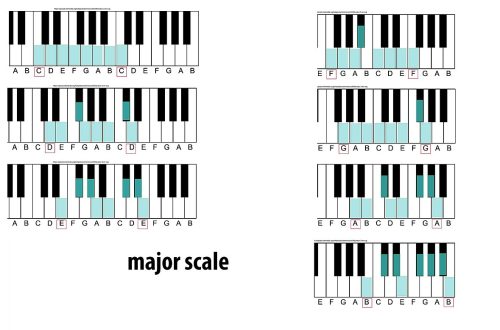
Scale, octaves and notes
Contents
What you need to know before starting the lesson:
- Musical sounds.
Scale and octave
Musical sounds form a musical sound range, which starts from the lowest sounds to the highest. There are seven basic sounds of the scale: do, re, mi, fa, salt, la, si. The basic sounds are called steps.
Seven steps of the scale form an octave, while the frequency of sounds in each subsequent octave will be twice as high as in the previous one, and similar sounds receive the same step names. There are only nine octaves. The octave that lies in the middle of the range of sounds used in music is called the First octave, then the Second, then the Third, the Fourth, and finally the Fifth. Octaves below the first have names: Small octave, Large, Controctave, Subcontroctave. The subcontroctave is the lowest audible octave. Octaves below the Subcontroctave and above the Fifth Octave are not used in music and have no names.
The location of the frequency boundaries of the octaves is conditional and is chosen in such a way that each octave begins with the first step (note Do) of a uniformly tempered twelve-tone scale and the frequency of the 6th step (note A) of the First octave would be 440 Hz.
The frequency of the first step of one octave and the first step of the octave following it (octave interval) will differ exactly 2 times. For example, the note A of the first octave has a frequency of 440 hertz, and the note A of the second octave has a frequency of 880 hertz. Musical sounds, the frequency of which differs twice, are perceived by ear as very similar, like the repetition of one sound, only at different pitches (do not confuse with unison, when the sounds have the same frequency). This phenomenon is called octave similarity of sounds .
natural scale
The uniform distribution of the sounds of the scale over semitones is called the temperament scale or the natural scale . The interval between two adjacent sounds in such a system is called a semitone.
A distance of two semitones makes a whole tone. Only between two pairs of notes there is no whole tone, it is between mi and fa, as well as si and do. Thus, an octave consists of twelve equal semitones.
Names and designations of sounds
Of the twelve sounds in an octave, only seven have their own names (do, re, mi, fa, salt, la, si). The remaining five have names derived from the main seven, for which special characters are used: # – sharp and b – flat. Sharp means that the sound is located higher by a semitone of the sound to which it is attached, and flat means lower. It is important to remember that between mi and fa, as well as between si and c, there is only a semitone, therefore there can be no c flat or mi sharp.
The above system of naming notes owes its appearance to the hymn of St. John, for the names of the first six notes, the first syllables of the lines of the hymn, which was sung in an ascending octave, were taken.
Another common notation system for notes is Latin: notes are denoted by the letters of the Latin alphabet C, D, E, F, G, A, H (read “ha”).
Please note that the note si is denoted not by the letter B, but by H, and the letter B denotes B-flat (although this rule is increasingly violated in English-language literature and some guitar chord books). Further, to add a flat to a note, -es is attributed to its name (for example, Ces – C-flat), and to add a sharp – is. Exceptions in names that denote vowels: As, Es.
In the United States and Hungary, the note si has been renamed to ti, so as not to be confused with the note C (“si”) in Latin notation, where it stands for the note before.




